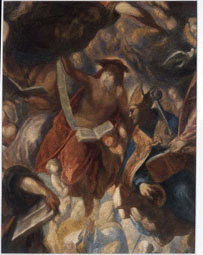'The St Jerome Group', detail from 'The Paradise' after Tintoretto
Angelo Alessandri (1854–1931), Italian. Watercolour and bodycolour on paper, 1880-1
WorkThis work is one of five watercolour studies of Tintoretto's vast oil painting (700x2200cm), The Paradise (1588-92), which is situated in the Chamber of the Sala del Maggior Consiglio, Doge's Palace, Venice. These studies were commissioned by Ruskin in a letter dated 29 June 1880. Ruskin asked Alessandri to leave 'white paper enough to surround them [St. Jerome] properly'(Works, 30, p. 199).
ArtistRuskin met Alessandri in the winter of 1877, when he found the young Italian painter at work in Venice's Accademia art gallery. He quickly set Alessandri to work on a series of Venetian studies destined for the Museum at Walkley and the teaching collection at Oxford. Alessandri began with canals and details from pictures by Carpaccio. Later, he was sent by Ruskin to copy works in Rome and Verona.Ruskin described Alessandri's work as 'most conscientious and lovely, [...] both in drawing architecture and copying fresco' (Works, 30, p. lix). Cook and Wedderburn reproduce two letters in which Ruskin gives advice to his new pupil. In January 1881, he wrote that 'I think you may soon do most beautiful things, if you once learn to see how vivid colour really is; and how necessary that one part should conduct to, and harmonise with, other parts.' (Works, 30, p. lx). In April 1881, he wrote 'Your study in drawing is to be with the pencil or pen, as you see all the great men studied theirs, and when you take the brush and dip it in a colour, remember always -- its line is to be as good as care (by the way) and luck will make it: but its laid COLOUR IS to be Right, -- whatever goes wrong to save it.' (Works, 30, p. lx).In his Master's Report of 1884, Ruskin explained that of all the copyists yet employed in the service of the Museum, Charles Fairfax Murray was the most skilful. Collection of the Guild of St George, Museums Sheffield
However, he explains, 'his prices have of late risen beyond our means; and I am now employing, with the best possible results, in the same field, a young Venetian, Mr. Alessandri, who in drawing architecture and copying frescos, gives us the most conscientious and lovely work, at prices which are just sufficient for his maintenance' (Works, 30, p. 72).
Ruskin on TintorettoRuskin became a passionate admirer of Tintoretto on seeing the works by him in the Scuola di San Rocco, and devoted a large portion of Modern Painters II, to a study of the painter. On 23 September 1845, Ruskin wrote to his father to express his joy and surprise in discovering these works:'I have been quite overwhelmed to-day by a man whom I never dreamed of -- Tintoret. I always thought him a good and clever and forcible painter; but I had not the smallest notion of his enormous powers. [...] It is marvellous lucky I came here, or I might have disgraced myself for ever by speaking slightly of Tintoret. I look upon Tintoret now, though as a less perfect painter, yet as a far greater man that Titian ipse...' (Works, 4, p. xxxvii).In his Venetian Index for travellers, Ruskin writes that 'Tintoret was not a man to work in any form or systematic manner; and, exactly like Turner, we find him recording every effect which Nature herself displays' (Works, 11, p. 412). |



















